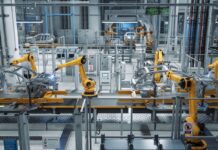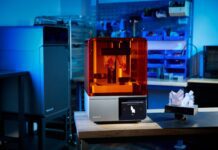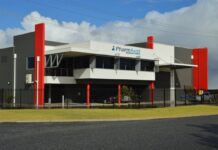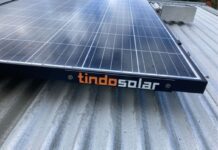
Media Release by Markforged
The expression “supply chain issues” is familiar to all Australians, from the manufacturer whose production line has stalled awaiting parts from an overseas supplier to the housewife walking past empty shelves in her local supermarket. Yet, ironically, this very unwelcome consequence of the Covid 19 pandemic is providing the drive for Australian manufacturers to produce more parts locally to reduce their dependence on imports.
The focus is on harnessing the benefits of the latest technologies, with 3D printing – additive manufacturing, or AM – providing a fast, efficient and low-cost entry point.
One of the world’s leading suppliers of AM printers, software and materials, US-based Markforged, has just launched its largest and fastest printer, the FX20, to an enthusiastic reception from Australian manufacturers and engineers.
At the Perth launch in October 2022 Richard Elving, Markforged’s Senior Director, Asia Pacific, said the parlous state of global logistics made it imperative for Australian manufacturers to become more self-sufficient.
Mr Elving pointed out that an estimated 40% of all components used by Australian manufacturers are sourced from China, with a large percentage of the balance coming from other offshore sources.
“Given the current supply chain issues, which show no sign of improving any time soon, it’s time for a major shift in mindset, time to completely reinvent manufacturing,” he said.
The benefits of thinking outside the traditional manufacturing box can be seen all around the world. A classic example is Tesla which, in recent years, has succeeded in reducing overall manufacturing costs per vehicle by over 50% by embracing a range of current automation and technology advances.
“AM had a role to play here,” said Mr Elving.
“Tesla replaced traditionally-manufactured spot welding shanks with components made on the premises on Markforged printers, reducing lead times and slashing the cost of each shank from $4,000 to $400. There was also a substantial saving in inventory costs since shanks could simply be printed as required,” he said.
Reduced inventory levels are a key benefit of AM.
Decades ago, companies accepted the expense of holding substantial parts inventories as a necessary operating cost. Then along came “Just in Time” (JIT), enabling manufacturers to delegate that responsibility to their suppliers, who undertook to deliver parts promptly, whenever needed.
Unfortunately, JIT simply cannot function in a world where prompt, reliable import/export logistics no longer exist.
“The choice facing manufacturers is to go back to the bad old days of costly, high inventory levels, accept long delays that will hamstring their production schedules, or find a cost-effective way of sourcing components locally. In many cases, this third option can be achieved at relatively low cost via a 3D printer that will consistently deliver industrial-grade components right where they are needed. In this way, AM can replace “just in time” with “just in place,” said Mr Elving
There is an interesting environmental spin-off here.
As “just in place” manufacturing gains ground, exporting parts from country to country will steadily reduce, with manufacturers printing components where they are needed, sourcing Cloud-based programs. This could substantially reduce the carbon footprint of the freight sector.
Componentry built on 3D printers has earned its stripes many times over, with AM products widely used across industry, from aerospace to agriculture, and it has passed many extreme tests.
Australian company Hadal Subsea, makers of the world’s deepest diving submersible, encountered problems with the stability of the mounts holding its underwater camera and side scan sonar, due to the immense pressures encountered at depth. There were long delays in having new prototype mounts designed and manufactured. Hadal fast-tracked the process by designing their own prototypes and using a Markforged printer to produce them at their Perth base. They were able to quickly make modifications after testing, and printed the final mounts themselves. These have been used successfully at depths of 11,000 metres, where the pressure exceeds 2,500 tonnes.
Introducing Markforged’s new printer, Richard Elving said the team developing the FX20 had nicknamed it “The Beast” because it offered more than twice the capacity of the largest Markforged printer made at the time.
“The good news is that this beast is actually a beauty, and one of its endearing features is that it works straight out of the box.”
“Some of the large printers on the market can take literally weeks – even months – to install, set up and configure. With the FX20 you just plug it into the wall, fire up your browser and you’re in business. You can literally uncrate it in the morning and be printing in the afternoon,” he said.
The printer’s versatility is enhanced by the wide range of materials Markforged has developed – there are presently 28 different options. It is currently the only 3D printer in the world offering continuous carbon fibre reinforcement, for high-performance applications in aerospace, defence, automotive and oil and gas. Carbon fibre-strengthened printed metals can be three times as strong as aluminium.
The FX20’s operating software is updated on a continuous basis, to provide ongoing improvement of the operation and productivity of the printer. Conventional manufacturing machinery requires ongoing maintenance and repairs if their initial productivity levels are to be sustained over time. By contrast the output rate of the FX20 – like all printers in the
Markforged range – will increase steadily throughout its working life. Thanks to regular software updates, current printers in the range have shown a three-fold increase in productivity over a five-year period. This makes the printer particularly attractive to companies using it for long production runs, where unit costs will steadily decrease over time.
“In summary, the FX20 will deliver advanced composite and metal industrial grade end-use parts on demand, at the point of need and, importantly, at costs normally well below those of similar items conventionally manufactured,” said Mr. Elving.
“Printers and materials of this quality seriously challenge the viability of traditional manufacturing methods, as well as the existing supply chain mentality.
“To all Australian manufacturers currently reliant on imported parts, and suffering delays and reputational damage in the process, I would pose one simple question – Is it better to get it overseas, or overnight?”




















